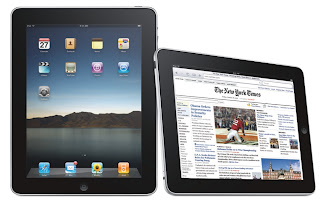Why you should buy the iPad


A great browser, fantastic ebook reader and video playback. What else do you need?
Light, beautiful and super fast… yes, the iPad has everything to grab your attention. But then you hear comments like, “it is too early to say if it will really work”, “it is nothing but a glorified iPod”, “I think I will wait for the next generation”, that leave you confused whether to buy one or not. Here are my thoughts on why and who should really look at grabbing an iPad.
So, what’s it got? A great web browser with zooming and email, fantastic video playback, Google Maps complete with Streetview, calendar, notes, YouTube and the standard iPod features.
The LED backlit LCD is sharp and has vivid colours, which makes watching videos an amazing experience. Plus, the images and movies can be viewed from any angle. Like the iPod or the iPhone, the screen is very responsive and supports multi-touch. A display resolution of 1024 x 768 pixels means that you will see the Web the way it was meant to; remember most netbooks stick to awkward resolutions and some sites don’t appear normal.
The iPad weighs about 700 gram, which makes it one of the lightest computer devices that you can carry around. At about 1.27 cm thick, it looks more or less like an A4 pad. However, take good care of the screen while carrying it around.
The battery is real good and lasts about 10 hours. This means you can charge it through the day and use it to check your email, update your social networking sites, look at a few videos and hear music when you return from office. After all this it will still have juice for you to catch up on the news at the breakfast table in the morning before it goes back to the charge dock.
A question commonly asked is will the iBook app on the iPad kill the Kindle? Well, there are two issues here. Not every book is available on iBook and most of the books are cheaper on Amazon. And since iPad has a reflective colour screen, long length reading can actually get heavy on the eyes. The same screen also makes the pages colour and the animation much better than the e-ink readers. The Apple app also makes readers feel like they are flipping through the pages of an actual book. Then, a double tap on a word lets you look up the dictionary for the meaning of the word. You can bookmark the word on that specific line and page, or search for it across the book.
What I hated about the iPod Touch was the feature I loved the most, the Accelerometer. I loved that by turning it sideways I could go from portrait to landscape mode. But at times this feature was annoying, especially when you are lying down and trying to use the device. The iPad, however, comes with a rotation lock that lets you turn off the Accelerometer when you want.
The onscreen keyboard is pretty large, but the missing numbers on the top row can cause some confusion. You will, however, get used to it with some practice. For me, the iPad keyboard dock accessory is a better option if you intend to type a bit on the iPad.
The missing Flash plug-in on the browser can be irritating since most websites use Flash these days. On the iPad, the Flash content appears as empty boxes for now. At the same time, YouTube videos work perfectly as it uses a different method to stream videos. Companies are already adopting content for the iPad, after all, within the first week of its launch, five per cent of web traffic emanated from it.
I like what I can do with the iPad — it works as a brilliant tool in a conference room for taking notes, updating a spreadsheet or making a presentation. Using applications such as Sales Force, Roambi and Evernote make me stay on top of my work, while Tweet Deck, FaceBook and YouTube keep me occupied.
Many other tablets are on the anvil, each with its own set of advantages and disadvantages. But, if you ask me, if iPad can’t multi-task, it means it will not crash easily and will perform better. Then the iPad comes from Apple and it a very attractive device despite the small annoyances like the missing front camera and Apple’s insistence on deciding who will put software on its devices.
If you feel it is too early for you to buy one, or that the price is not right — the iPad will carry an import duty of about Rs 9,000 in India — wait for the market to heat up with the new Android-based tablets. But if you want to own a shiny new thing that makes you happy and does what you really want, got buy an iPad.
--
The above article was printed in the Indian Express on Sunday, 25th April 2010



